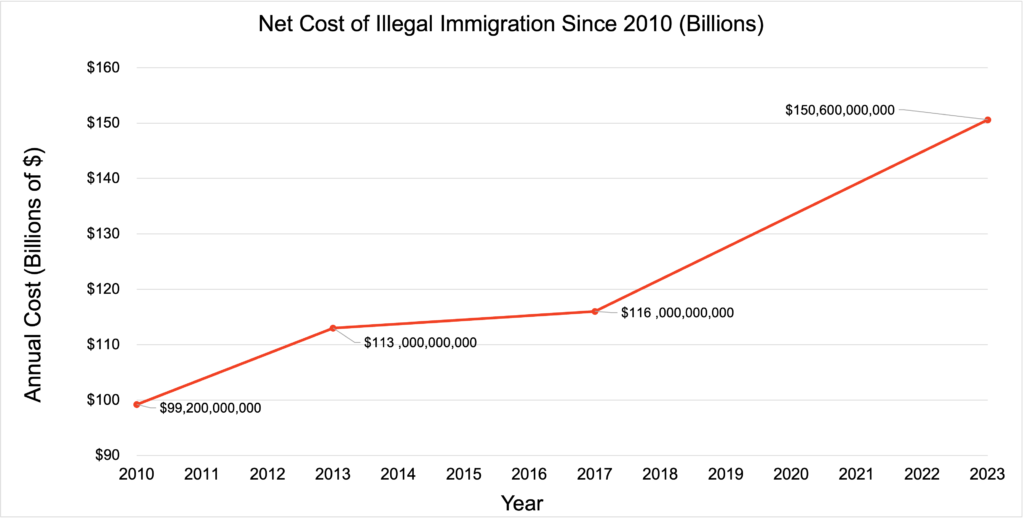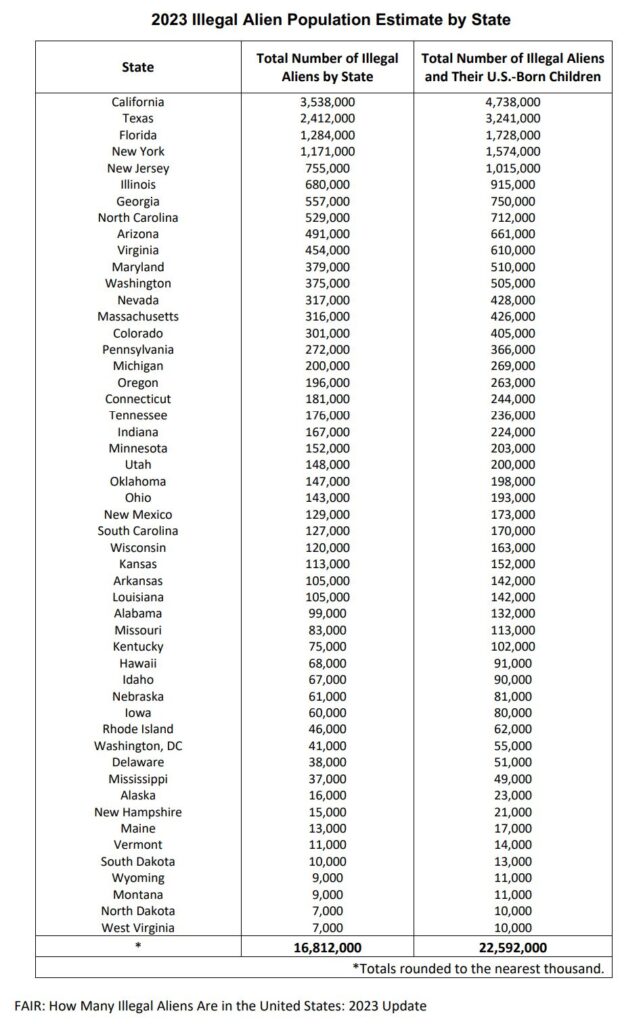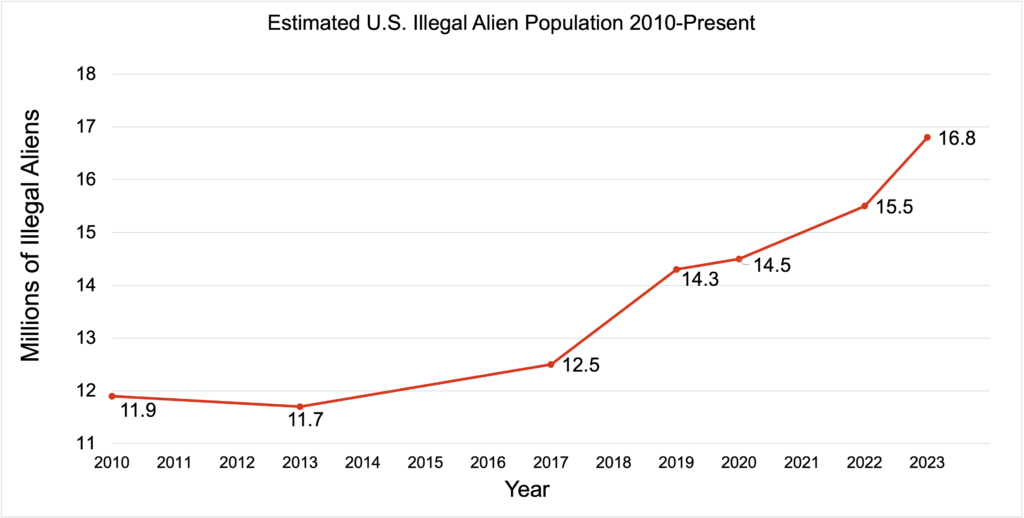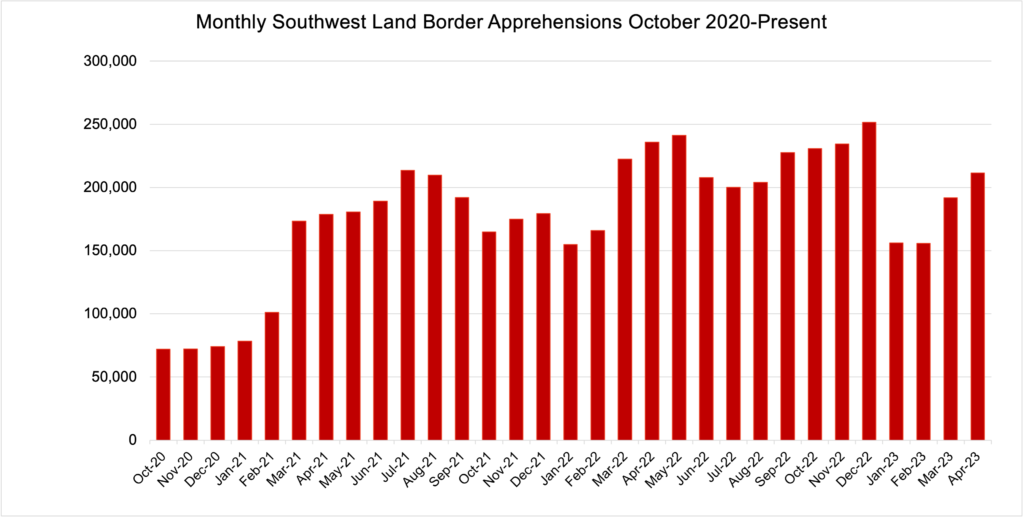A FAIR Research Report | June 2023
FINDINGS
As of June 2023, FAIR estimates that approximately 16.8 million illegal aliens reside in the United States. This is significantly higher than our January 2022 illegal alien population estimate of 15.5 million.[1] This estimate is also a 2.3 million increase from our end-of-2020 estimate, meaning the illegal alien population increased 16 percent nationwide during just the first two years of Joe Biden’s presidency.

FAIR’s most recent comprehensive fiscal cost study showed that illegal aliens and their U.S.-born children impose a net annual cost of $150.6 billion on American taxpayers as of the beginning of 2023. According to the previous (2017) cost study, the annual net cost of illegal migration was approximately $116 billion.[2] This means that in the short span of 5 years, the annual cost to American taxpayers has increased by nearly $35 billion. When further adjusted for the increased illegal alien population growth demonstrated by this report, taxpayers are being set up for annual spending to the tune of $163 billion and counting. This burden will only continue to grow as a result of the Biden administration’s open-borders policies.
WHO IS AN ILLEGAL ALIEN?
An illegal alien is simply any alien who is present in the United States without legal status, like a valid visa or lawful permanent residence.
It is important to note that “legal status” is not the same as “lawful presence.” For example, recipients of deferred action, deferred enforced departure, Temporary Protected Status (TPS), or parole do not have legal status. These programs (some of which are authorized by statute, some are not) do not give illegal aliens visas or green cards. They merely defer deportation for a period of time.
Nevertheless, these aliens are still described as “lawfully present” or as having “lawful presence.” That is because “lawful presence” is a term of art under immigration law designed to clarify that although an alien has no legal status, he or she is not accruing unlawful presence under Immigration and Nationality Act (INA) Section 212(a)(9) for purposes of the three and ten-year bars.[3]
Under INA Section 212(a)(9), an alien who has no legal status will start to accrue days of unlawful presence. If the alien accrues more than 180 of unlawful presence and is then deported or otherwise leaves, the alien is barred from admission for three years. If the alien accrues 365 or more days (one year) of unlawful presence and is then deported or otherwise leaves, s/he is barred from admission for ten years.[4]
However, if an alien is granted a deferral of deportation, such as deferred action, the deferral would not be meaningful if, by staying, the alien could be barred from re-entry for three to ten years. To avoid this outcome, the former Immigration and Naturalization Service (INS), now United States Citizenship and Immigration Services (USCIS), essentially deemed that aliens with such deferrals are “lawfully present” so that they do not accrue days of unlawful presence and are not subject to the statutory bars.[5]
For this study’s purposes, we use the definition that conforms to U.S. immigration law and consider individuals present in the U.S. without legal status to be illegal aliens, regardless of any deferments applicable to their removal or accrual of unlawful presence. Counting individuals in these situations as “legal immigrants” or “lawful residents” would be both incorrect and a biased mischaracterization of immigration law.
FAIR offers additional details on who should be considered an illegal alien in our study titled “Why ‘Illegal Alien’ is the Correct Term.”[6]
CHALLENGES ESTIMATING THE ILLEGAL ALIEN POPULATION
Estimating the size, distribution, and characteristics of the illegal alien population is an inexact science. The methods used by those claiming to have calculated a definitive figure should be viewed skeptically, as there is no completely reliable source of information on illegal aliens. The Department of Homeland Security (DHS) only (loosely) counts foreign nationals who enter and leave the United States in a lawful manner, and its illegal alien population estimates remain unhelpful due to underestimating the size of the population and utilizing outdated numbers.[7] In truth, we do not know exactly how many people cross the border illegally and evade immigration authorities, nor can anyone accurately quantify overstays or gotaways. We can only estimate these figures based on changes in annual census data, along with how many individuals CBP and ICE believe slip through undetected.
Most of the current estimates regarding the total number of illegal aliens are based on U.S. Census Bureau data. Unfortunately, far too many of these tallies presume that essentially all unlawful migrants are willing to respond to demographic questionnaires and that they provide accurate information to federal officials. As people whose very presence in the United States is the result of a violation of law, many illegal aliens understandably see no personal benefit in revealing any information about their nativity or true immigration status. Therefore, when asked about how, when, and why they entered the United States, illegal aliens have a strong motive to either lie, claiming they are lawful immigrants or citizens, or refuse to respond at all. There are no repercussions for illegal aliens who fail to respond to annual Census Bureau survey programs such as the American Community Survey (ACS) or the Current Population Survey (CPS).
Indeed, there are few mechanisms in place to verify the accuracy of the information respondents provide. In fact, the Census Bureau’s weighted results from the ACS can vary by millions, depending on what information is requested and how questions are phrased.[8] As a result, we should avoid relying solely on raw totals from the Census Bureau.
HOW WE REACHED OUR ESTIMATE
To determine FAIR’s estimate of the total number of illegal aliens in the United States, we first calculated an approximate total number of all foreign-born residents currently presumed to be living here. To do this, we first analyzed the latest relevant information available from the Census Bureau’s September 2021 ACS and the April 2023 CPS.[9]
It bears repeating that the ACS and CPS do not capture the entire illegal alien population in the United States. In the past, most reputable research organizations routinely acknowledged large-scale, widespread and systematic undercounting in surveys of the illegal alien population. Understandably, many illegal aliens are reluctant to engage with government surveys and many do not even live in residential addresses within the survey pool. Because of this simple fact, older estimates frequently attempted to account for the much lower response rate of illegal aliens.
However, as the number of illegal aliens continues to increase, many of these organizations stand to benefit from a false perception that illegal immigration is not the severe and ongoing issue that it is. For policy reasons, they now downplay or even entirely fail to account for undercounts and low response rates, creating a false impression that the illegal alien population in the United States is significantly smaller than in reality. The idea that the population of illegal aliens has not increased to a substantial degree in a decade, especially given the collapse of immigration enforcement under the Biden administration, is unrealistic.
After we ascertained a base estimate of illegal aliens, as captured by the ACS and CPS, by comparing the total number of foreign-born individuals with the aggregated population of naturalized citizens, permanent residents, and valid visa holders, we applied a conservative estimate that the illegal alien population is being undercounted by approximately 30 percent, consistent with past estimates of nonresponse rates for illegal aliens. We also took into account the makeup of recent increases in the measured foreign-born population, which contain a higher proportion of illegal immigrants than previous years due to inadequate border security and the expansion of dubious immigration parole programs. Our estimate is comparable to the general consensus of non-partisan experts regarding the accuracy of Census data.[10] Using this method, we reached our estimate of 16.8 million illegal aliens residing in the U.S.
WHAT’S DRIVING THE NUMBERS?
This alarming and rapid increase in the illegal alien population can be attributed to several factors:
I. During the post-COVID recovery, U.S. employers and businesses began to re-open, re-hire old workers, and hire new workers. In addition, border and flight restrictions were relaxed globally, making access to the United States and its borders easier.
The post-COVID economic recovery was attractive to illegal aliens, who are primarily economic migrants. Even if the U.S. economy shows signs of strain, it is in many respects still healthier than other countries and today remains a powerful magnet for foreign nationals who want to work in the U.S. and often remit their wages home. This improving economic situation, combined with easing travel restrictions in the hemisphere and indeed the world, made it easier to make the journey to cross the Southern border illegally. Easing travel restrictions and diplomatic post closures also made U.S. visas easier to obtain, resuming the steady influx of visa overstayers (who become illegal aliens when the terms of their visas are violated) into the illegal alien population.
II. The Biden Administration’s policies created strong pull factors that encouraged more illegal immigration, often exacerbating external push factors.
Many of these policies were implemented during the first few months of the Biden administration. Important examples include the following:
- Throughout the 2020 campaign, President Biden promised to extend amnesty to illegal aliens in the United States.
- On his first day in office, President Biden sent an immigration bill to Congress that included an amnesty program and pledged his support to give illegal aliens a path to citizenship.
- The Biden administration immediately issued an executive order directing agencies to take steps to preserve the Deferred Action for Childhood Arrivals (DACA) program.
- The Biden administration stopped construction of the border wall.
- The Biden administration expanded the grounds for claiming asylum by reversing legal opinions issued under the Trump Administration.
- The Biden administration ended the Asylum Cooperative Agreements (ACAs) with Guatemala, El Salvador, and Honduras which required migrants to apply for asylum in one of the countries through which they traveled (and be denied) as a prerequisite to eligibility for asylum in the United States.[11]
- The Biden administration issued a policy to exempt unaccompanied minors and family units from expulsion under Title 42, releasing these populations into the U.S.
- The Biden administration revived the Obama Administration’s policy of allowing immigration judges to administratively close deportation cases.
- U.S. Citizenship and Immigration Services (USCIS) issued policies that make it easier to apply for benefits, including work permits, extended and expanded programs like Temporary Protected Status, eliminated the ability of officers to issue Notices to Appear (NTAs), and reduced screening and vetting in order to process more petitions and applications.
Not surprisingly, soon after Biden’s election, the number of illegal border crossings rose dramatically. Many migrants expressly stated they were entering the United States because they felt President Biden was inviting them. Some even wore t-shirts with the President’s name on them.[12]
Since that time, the number of apprehensions (arrests and expulsions combined) at the Southwest border has risen to unprecedented levels. A total of 2.4 million illegal aliens were apprehended at the U.S.-Mexico border in Fiscal Year (FY) 2022. This is a record-breaking annual number that even surpassed the FY 2021 total of more than 1.7 million.[13] In the first seven months of FY 2023 alone, apprehensions have already exceeded 1.4 million and are easily on pace to match the previous years’ grim records. Hundreds of thousands of these individuals were released into the country to await an adjudication on what are often fraudulent asylum claims. Additionally, over a million gotaways completely evaded border inspection and law enforcement.[14] As can clearly be seen from a visualization of apprehensions, the Biden administration’s levels are consistently at an extremely high level that exceeds all previous administrations.
III. Third, the Biden Administration began to release illegal aliens en masse into the United States.
Rescission of “Remain in Mexico.”
One of the first actions President Biden took was to end the successful Migrant Protection Protocols (MPP, or “Remain in Mexico” program). Ending this program meant that illegal aliens apprehended at the border would now be released into the U.S. while their removal cases were pending instead of waiting in Mexico for a scheduled asylum case. A federal judge ordered the administration to restart the program, but very few migrants were actually placed in the program after that court order.[15] Ultimately, in June 2022, the Supreme Court ruled that the Biden administration could legally rescind “Remain in Mexico.”[16]
Notices to Report Replacing Notices to Appear.
When an individual enters the U.S. without legal authorization the alien must either be processed through expedited removal and removed swiftly or the alien is referred to immigration court through a Notice to Appear. A Notice to Appear, which must be given to asylum-seekers who are determined to have “credible fear”, informs the alien that he or she is in the U.S. in violation of our immigration laws and is subject to deportation. It orders him or her to appear at a scheduled date before an immigration judge to plead their case for legal relief. This system is already subject to tremendous multi-year backlogs due to a glut of frivolous asylum cases,[17] but one ad-hoc practice by the Biden administration simply subverted it entirely with even worse consequences.
From March to September 2021, the Border Patrol, at the direction of the Biden Administration, began issuing Notices to Report (NTR) instead of NTAs to illegal alien families arriving at the border in a bid to reduce processing time. These notices simply directed individuals in these family units to report to ICE at a time in the future to receive a court date, and the individuals were then released without monitoring or oversight and only providing very limited address information. Approximately 94,000 individuals received NTRs before the program was terminated due to very concerning results.[18] A large proportion of these individuals never reported back to ICE and simply disappeared from monitoring because these notices were effectively unenforceable and did not collect adequate information.
Parole of Aliens Apprehended at the Border.
One of the most egregious ways the administration facilitated catch-and-release was through massive abuse of immigration parole authority to release illegal aliens into the United States. This was a direct violation of federal statute. When Congress drafted a statute authorizing immigration parole, which allows inadmissible aliens to be released while their case is pending, it intended parole to be utilized solely on an extremely limited, case-by-case, temporary basis. According to Section 212(d)(5) of the Immigration and Nationality Act (INA), the government may only grant parole to an alien for “urgent humanitarian reasons” or “significant public benefit.”[19] In addition, Section 235(b)(1)(B)(ii) of the INA requires that aliens be detained (“shall be detained”) while their asylum applications are considered, showing clear congressional intent that detention is mandatory and immigration parole cannot be the default.[20]
Nevertheless, the Biden Administration has abused the parole authority to release a huge number of illegal aliens apprehended at the border into the United States.[21] Many of these individuals fail to appear at their hearings[22] and face little to no consequences. The immigration court backlog reached 2.1 million in January 2023, a 66 percent increase from FY 2020 (the last full fiscal year of the Trump administration), largely thanks to these parole releases.[23]
- Parole + ATD.
Parole Plus Alternative to Detention (Parole + ATD) was a CBP program whose formal use ran from November 2021 to its demise in federal court in March 2023. [24] The program, first applied to family units and additionally to individuals after July 2022, admitted illegal aliens arriving at the Southwest border into the country under parole authority. These aliens were given some form of tracking, like ankle bracelets or even just a smartphone app, and then allowed to enter the U.S.
As with the NTR debacle, these individuals were not issued NTAs but rather directed to receive them at a later date. At one point under this policy, tens of thousands of illegal aliens were being released into the U.S. every month with minimal oversight.[25] The haphazard release of a significant number of these aliens without A-numbers, vital for case tracking and future immigration court cases, left thousands untraceable to the government.[26]
- Parole with Conditions.
The Biden Administration issued the Parole with Conditions policy just as Title 42 was coming to an end,[27] and it was quickly halted by a lawsuit before fully coming into effect. Nevertheless, it signaled the Biden Administration’s single-minded determination to release as many illegal aliens into the United States as possible. This CBP policy would have allowed the Border Patrol to indiscriminately release illegal aliens into the U.S. from any port of entry experiencing crowding. Illegal aliens released under the policy would only be required to provide an address, with no verification of residence, and be directed to report to an ICE office at a later date to receive an NTA.[28]
Categorical Parole Programs.
In addition to paroling in illegal aliens apprehended at the border, the Biden Administration created new programs out of thin air that would allow otherwise inadmissible aliens to enter the U.S. and work. In March 2021, the Biden administration re-launched the Obama-era parole program for Central American minors (CAM Program), eventually expanding the categories of eligible petitioners. In addition, it announced a dubious “Family Reunification Parole Process” to circumvent existing visas available to relatives of American citizens and permanent residents.[29] It has also abused its parole authority by paroling in tens of thousands of Afghan (Operation Allies Welcome) and Ukrainian (Uniting for Ukraine) citizens without valid visas as well as other nationals.[30] Most recently in January 2023, the Biden administration launched a program to parole up to 360,000 otherwise inadmissible migrants annually from Cuba, Haiti, Nicaragua, and Venezuela.[31]
IV. The Biden Administration Prevents the Arrest and Deportation of Illegal Aliens Already in the United States.
Restrictions Placed on Immigration and Customs Enforcement.
Soon after taking office, President Biden took steps to severely limit ICE officials from detaining and removing most non-criminal immigration violators.[32] On day one, the Acting Secretary of Homeland Security issued a 100-day moratorium on deportations and set new, interim enforcement priorities which clearly indicated that simply being an illegal alien would no longer subject an alien to deportation proceedings.[33] The 100-day moratorium on deportations was later enjoined by a court; however, the interim priorities for enforcement remained in place. And not long thereafter, ICE issued another memo that required agents to seek preapproval for enforcement actions in all non-priority cases.[34]
In September of 2021, Secretary Alejandro Mayorkas formally adopted the same enforcement priorities for the department.[35] These enforcement priorities limited the arrest and initiation of deportation proceedings, as a general practice, to aliens who posed a threat to national security, to public safety, and to border security. Even with regard to public safety, the enforcement guidance encouraged agents to apply broad mitigating factors when deciding to initiate deportation proceedings against criminals. And with regard to illegal aliens who had not come in contact with law enforcement, Secretary Mayorkas essentially declared they were now off limits. He stated, “The fact an individual is a removable noncitizen therefore should not alone be the basis of an enforcement action against them.”
In June 2022, due to a lawsuit brought by Texas and Louisiana, a federal district court in Texas issued a judgment vacating the memorandum and on November 29, 2022, the Supreme Court granted the administration’s request to review the case and heard arguments.[36] However, as with other Biden policies, the damage was already done. As one cartel coyote admitted, both the cartels and illegal border crossers appreciated and were encouraged by Biden’s softness on removals.[37]
Temporary Protected Status.
The Biden administration has implemented new Temporary Protected Status (TPS) designations for several nations, such as Ukraine, Venezuela, and Ethiopia while failing to end any existing designations – even in situations where the original reasons for granting TPS have long been resolved.[38] Approximately 670,000 illegal aliens in the U.S. are eligible for or beneficiaries of TPS, including 135,000 under new Biden administration designations or extensions.[39] TPS, despite its name, is not a permanent legal status but simply defers the deportation of illegal aliens. Therefore, its recipients are included in our estimates. As residents from more and more countries are offered TPS, as the open-borders lobby constantly urges, fewer illegal aliens will be removed from the country.
Ending Title 42 Expulsion Authority.
Most recently, President Biden officially ended the COVID-19 public health emergency designation and the Title 42 authority to expel illegal aliens under it, on May 11, 2023. While the policy was still in place in 2021 and 2022, it was common knowledge – including for human smugglers and illegal migrants – that the Biden administration intended to end Title 42 expulsions. This both generated anticipation and was perceived as an invitation by prospective border jumpers.
WHERE DO ILLEGAL ALIENS LIVE IN THE UNITED STATES?
Unsurprisingly, most illegal aliens tend to live near the United States’ border with Mexico or in states with “sanctuary” policies that purport to offer welcoming environments and protection from immigration enforcement. The ten states with the largest estimated illegal alien populations account for just under three-fourths (70.6%) of the national illegal alien total.
However, this does not mean that states which hold a comparatively small share of the illegal alien population are unaffected by its negative impact. In fact, as FAIR has pointed out in other studies, illegal immigration often hits these states the hardest, as it is more difficult for low-population areas to absorb the impacts of illegal immigration.[40]
The following graphic estimates how many illegal aliens reside in each state, as well as the total number of illegal aliens and their U.S.-born children.

REFERENCES
[1] “How Many Illegal Aliens Are in the US: 2022 Update,” Federation for American Immigration Reform, April 12, 2022, https://www.fairus.org/issue/illegal-immigration/how-many-illegal-aliens-were-us-2022-update.
[2] Ibid.
[3] Donald Neufeld, Lori Scialabba, and Pearl Chang to Field Leadership, “Interoffice Memo Re: Consolidation of Guidance Concerning Unlawful Presence for Purposes of Sections 212(a)(9)(B)(i) and 212(a)(9)(C)(i)(I) of the Act”, U.S. Citizenship and Immigration Services, May 6, 2009 https://www.uscis.gov/sites/default/files/document/memos/revision_redesign_AFM.PDF.
[4] Immigration and Nationality Act § 212(a)(9), https://uscode.house.gov/view.xhtml?req=granuleid:USC-prelim-title8-section1182&num=0&edition=prelim.
[5] Neufeld et al., “Interoffice Memo Re: Consolidation of Guidance”, Ibid.
[6] Matt O’Brien, Spencer Raley, and Casey Ryan, “Why ‘Illegal Alien’ is the Correct Term,” Federation for American Immigration Reform, July 2018, https://www.fairus.org/issue/border-security/why-illegal-alien-correct-term.
[7] “Estimates of the Unauthorized Immigrant Population Residing in the United States,” U.S. Department of Homeland Security, page last updated October 2022, https://www.dhs.gov/immigration-statistics/population-estimates/unauthorized-resident. The most recent estimate was published in April 2021 but relies on data from January 2015 to January 2018. It claimed that 11.4 million illegal aliens lived in the U.S.
[8] Basing the total number of foreign-born residents in the United States on responses to the ACS question requesting citizenship information typically yields a weighted total that is more than two million individuals lower than when the estimate is based on survey questions regarding how long respondents have lived in the country. In the case of this population update, the current population survey (CPS) monthly total for April 2023, corrected for the imbalance that exists between the “citizenship” and “years in the USA” categories, shows an increase in the foreign-born population of approximately 3.29 million since the 2021 ACS (around September of that year) for a total foreign-born population of 49.8 million in the USA as of May 2023 (not accounting for undercount of illegal aliens). The definition of foreign-born here excludes individuals born in foreign countries to one or two American parents.
[9] U.S. Census Bureau, “American Community Survey (ACS),” https://www.census.gov/programs-surveys/acs.
[10] To estimate the total number of lawful immigrants and lawful foreign-born residents in the United States, we examined both data from the ACS, CPS, and the comprehensive Yearbook of Immigration Statistics published annually by the DHS. This is the approach most commonly used by other reputable organizations that produce estimates on this matter.
[11] Madison McQueen and Jason Pena, “Biden’s Border Crisis 101: How This Administration’s Policies Created a Self-Inflicted Crisis,” Federation for American Immigration Reform, April 2021, https://www.fairus.org/issue/border-security/bidens-border-crisis-101.
[12] Shelby Talcott, “PHOTOS: Migrants Wearing ‘Biden Please Let Us In’ Shirts Hold Demonstration At US Border”, Daily Caller, March 4, 2021, https://dailycaller.com/2021/03/04/photos-migrants-biden-let-us-in-demonstration-us-mexico-border/.
[13] U.S. Customs and Border Protection, “Southwest Land Border Encounters,” last modified May 17, 2023, https://www.cbp.gov/newsroom/stats/southwest-land-border-encounters.
[14] Federation for American Immigration Reform, “‘Gotaways’ Surge Across Border; Expect More Crimes to Follow,” May 23, 2023, https://www.fairus.org/blog/2023/05/23/gotaways-surge-across-border-expect-more-crimes-follow.
[15] Adam Shaw, “Biden Admin Enrolled Fewer Than 300 Migrants in ‘Remain in Mexico’ in December,” Fox News, January 25, 2022, https://www.foxnews.com/politics/biden-admin-enrolled-fewer-migrants-in-remain-in-mexico-in-december.
[16] Federation for American Immigration Reform, “Supreme Court Greenlights the Continuation of Biden’s Border Crisis,” June 30, 2022, https://www.fairus.org/press-releases/presidential-administration/border-security/supreme-court-greenlights-continuation.
[17] TRAC Immigration, “Immigration Court Backlog Tool,” last updated January 2023, https://trac.syr.edu/phptools/immigration/court_backlog/.
[18] Rebecca Gambler, “Southwest Border: Challenges and Efforts Implementing New Processes for Noncitizen Families”, Government Accountability Office, October 17, 2022, https://www.gao.gov/products/gao-22-105456.
[19] Immigration and Nationality Act § 212(d)(5)(A), https://www.law.cornell.edu/cfr/text/8/212.5.
[20] Immigration and Nationality Act § 235(b)(1)(B)(ii), https://www.law.cornell.edu/cfr/text/8/235.3
[21] This is especially notable as paroled aliens are generally eligible for work authorization and many welfare benefits, making parole status a goal for huge numbers of economic migrants. The number of people on the non-detained docket (i.e., waiting for a hearing with an immigration judge while not in immigration detention) has surpassed 5 million people. See Todd Bensman, “‘Catch and Release’ Resumes on Texas Border in the Face of Rising Migrant Numbers,” Center for Immigration Studies, February 3, 2021, https://cis.org/Bensman/Catch-and-Release-Resumes-Texas-Border-Face-Rising-Migrant-Numbers.
[22] Adam Shaw, “DHS Chief Reveals Startling Stat on Asylum Seekers Who Skip Hearings, Disappear,” Fox News, June 11, 2019, https://www.foxnews.com/politics/dhs-secretary-reveals-startling-stat-on-asylum-seekers-who-skip-hearings-disappear/.
[23] “Immigration Court Backlog Tool,” University of Syracuse TRAC Immigration, last updated January 2023, https://trac.syr.edu/phptools/immigration/court_backlog/.
[24] Andrew R. Arthur, “Federal Judge Vacates Biden’s ‘Parole+ATD’ Border Release Policy”, Center for Immigration Studies, March 10, 2023, https://cis.org/Arthur/Federal-Judge-Vacates-Bidens-ParoleATD-Border-Release-Policy.
[25] From March to September 2022, for example, at least 24,000 illegal aliens a month were released under this program with a September high of over 95,000. See “Custody and Transfer Statistics FY2022”, U.S. Customs and Border Protection, https://www.cbp.gov/newsroom/stats/custody-and-transfer-statistics-fy22.
[26] Michael Capuano, “Border Patrol Audit Shows Crucial Step Being Skipped, Harming Americans and Migrants Alike”, Federation for American Immigration Reform, September 29, 2022, https://www.fairus.org/blog/2022/09/29/border-patrol-audit-shows-crucial-step-being-skipped-harming-americans-and-migrants.
[27] Raul Ortiz, “Policy on Parole with Conditions in Limited Circumstances Prior to the Issuance of a Charging Document (Parole with Conditions)”, U.S. Customs and Border Protection, https://storage.courtlistener.com/recap/gov.uscourts.flnd.464923/gov.uscourts.flnd.464923.7.1.pdf.
[28] Ibid.
[29] U.S. Citizenship and Immigration Services, “Family Reunification Parole Processes,” May 10, 2023, https://www.uscis.gov/FRP.
[30] George Fishman, “Parole with Benefits,” Center for Immigration Studies, April 13, 2023, https://cis.org/Report/Parole-Benefits.
[31] Ira Mehlman, “Biden Illegally Asserts the Authority to Parole 360,000 Inadmissible Aliens a Year,” FAIR Newsletter, February 2023, https://www.fairus.org/biden-illegally-asserts-authority-parole-360000-inadmissible-aliens-year.
[32] Hillel Smith, “The Biden Administration’s Immigration Enforcement Priorities: Background and Legal Considerations,” Congressional Research Service, updated December 9, 2022, https://sgp.fas.org/crs/homesec/LSB10578.pdf.
[33] David Pekoske to Troy Miller et al., “Review of and Interim Revision to Civil Immigration Enforcement and Removal Policies and Priorities”, U.S. Department of Homeland Security, January 20, 2021, https://www.dhs.gov/sites/default/files/publications/21_0120_enforcement-memo_signed.pdf.
[34] Tae Johnson to All ICE Employees, “Interim Guidance: Civil Immigration Enforcement and Removal Priorities”, U.S. Immigration and Customs Enforcement, February 18, 2021, https://www.ice.gov/doclib/news/releases/2021/021821_civil-immigration-enforcement_interim-guidance.pdf.
[35] Alejandro Mayorkas to Tae Johnson et al., “Guidelines for the Enforcement of Civil Immigration Law”, U.S. Department of Homeland Security, September 30, 2021, https://www.ice.gov/doclib/news/guidelines-civilimmigrationlaw.pdf.
[36] Congressional Research Service, “Enforcement Priorities,” Ibid.
[37] Pawel Styrna, Book Review: “The Main ‘Root Cause’ of the Border Crisis is Joe Biden’s ‘Invitation,’” Federation for American Immigration Reform, March 24, 2023, https://www.fairus.org/blog/2023/03/24/book-review-main-root-cause-border-crisis-joe-bidens-invitation.
[38] Preston Huennekens, “Mayorkas Grants TPS to Rapidly Resettled Afghans,” Federation for American Immigration Reform, March 2022, https://www.fairus.org/legislation/presidential-administration/amnesty/mayorkas-grants-tps-rapidly-resettled-afghans. Also see U.S. Citizenship and Immigration Services, “Temporary Protected Status,” last updated March 13, 2023, https://www.uscis.gov/humanitarian/temporary-protected-status.
[39] Mohamad Moslimani, “How Temporary Protected Status has expanded under the Biden administration”, Pew Research Center, April 21, 2023, https://www.pewresearch.org/short-reads/2023/04/21/biden-administration-further-expands-temporary-protected-status-to-cover-afghanistan-cameroon-ukraine/.
[40] Matt O’Brien, Spencer Raley, and Casey Ryan, “Small Migrant Populations, Huge Impacts,” Federation for American Immigration Reform, February 2020, https://www.fairus.org/issue/societal-impact/small-migrant-populations-huge-impacts-even-states-few-immigrants-hit-costs.
Read Full Research Report on FairUS.org








